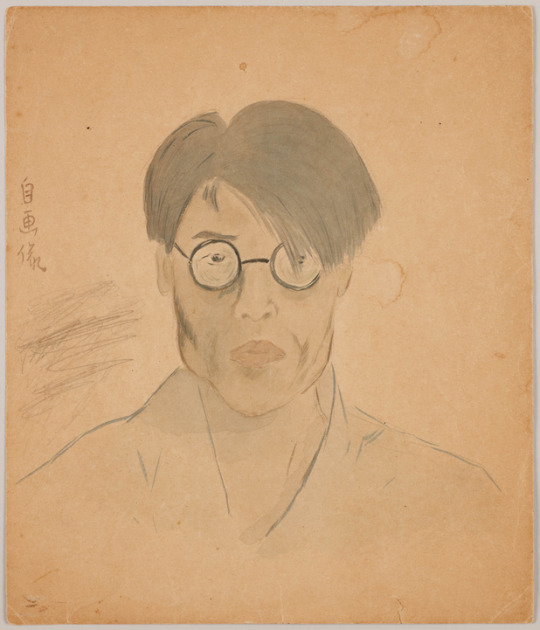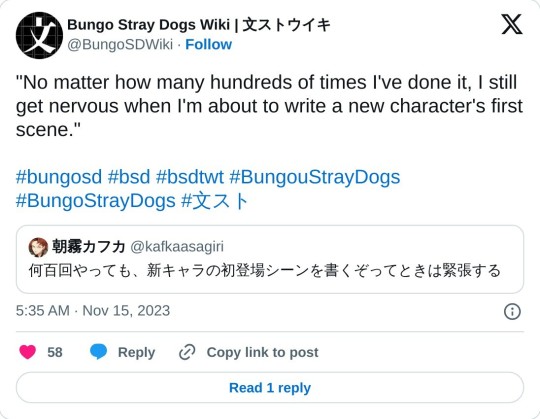They/Them・Self-Proclaimed bibliophile with a penchant for 積ん読・BSD/BunAl Wiki Admin
Don't wanna be here? Send us removal request.
Text
"Artists of the past could at least keep silent in the face of tyranny. The tyrannies of today are improved; they no longer admit of silence or neutrality. One has to take a stand, be either for or against. Well, in that case, I am against."
— Albert Camus, The Artist and His Time
Hi all. Long time no speak. As of writing this my country is facing it's greatest threat once more; backsliding into the chains of authoritarianism and fascism. As I have always stood firm, my stance is that I support and hope for the liberation of all peoples and against tyranny and fascism. May God give my people strength to walk the path for liberation.
7 notes
·
View notes
Note
I want to speak out against the whole push towards DEI. I feel that ever since you made the push to make identity the forefront of a character it has hurt the stories you tell. Captain Sisay's race was never the focus of her character and she was a complete badass! And I fear if you did it over again Gerrard would be trans, black and disabled just because. It also cheapens the stories of world devastation when characters worry more about their gender than Bolas destroying everything.
The reason I started this blog is so we can have frank conversations about things, so please let’s talk about this.
Imagine if every time you turned on the TV or watched a movie, no one looked like you. For some of us, that’s never happened. We see ourselves constantly, so it’s hard to truly understand what not seeing yourself represented in media is like.
I do have a personal window to this experience. While I am white and male, there’s an area where I am the minority - my religion. Jews are just under two and a half percent of the US population. I have had many experiences where I’ve been in situations where everything is geared towards a group I do not belong to, and zero consideration is given that not everyone at that event is part of the majority.
You just feel invisible and like an outsider. It’s not a great feeling. And I just experience it a tiny portion of time, only things that are geared specifically towards something religious. Most minorities have this feeling all the time, whenever they’re outside their personal community.
Now imagine, after years of not seeing yourself ever, you finally see someone that looks like you, but nothing about the character rings remotely true. They don’t sound like you, they don’t act like you, the facts about their day-to-day life are just wrong. It’s clear whoever wrote the character didn’t truly understand the lived experience of the character, so the character feels fake.
You bring up Sisay. Michael Ryan and I didn’t technically create Sisay (she played a small role in the Mirage story), but we did do a lot to flesh out her character as the creators of the Weatherlight Saga. We turned her from a minor character into a major one.
And while I’m proud, in general, of our work on the Weatherlight Saga, I don’t think we did justice to Sisay as a character. Neither Michael nor I have any knowledge of what it’s like to be a black woman. Nor did we ever talk to someone who did.
And if you’re someone like us that has no knowledge of that experience, you probably didn’t notice. But that doesn’t mean it’s a good thing.
Imagine if we made a movie about your life, and we just made everything up. We invented people you never knew, we gave you a job you never had, and we had you say things you’d never say. The movie might even be a good movie, but your response would be, but that’s not my life - that’s not me.
Now imagine we put the movie out, and people that never met you assumed that was what you were like. When people met you for the first time, they assumed things, because, you know, they’d seen the movie.
That’s what misrepresenting people does. It not only makes them feel not seen, it falsely represents them, spreading lies, often stereotypes, making people believe things about them that aren’t true.
Our move towards diversity is just us trying to better reflect the world and the people in it. We’re trying to do to everyone else what a certain portion of people get every day without ever having to think about it.
But why are we “making it the forefront of their character”? We’re not. We’re making it a part of their character. But in a world where you’re not used to ever seeing it, it feels louder than it is. Things that are a natural part of the world that you’re used to feel like the background of the story because you understand the context to it.
If a man kisses his wife before going off to a battle, that’s not a big deal. It’s just a thing a husband might do to his wife when he leaves. It’s not the forefront of his character. It’s just part of his life. But you’ve seen it hundreds of times, so it feels normal.
When someone does something that isn’t your lived experience it pulls focus. It seems like a big deal, but only because it’s new to you. It’s just as mundane a thing to that character as the man kissing his wife is to him.
Even the turn “pushing” implies that it’s unnaturally here, that we’re forcing something that naturally shouldn’t be. But why? That thing exists naturally in the real world, and it doesn’t make the real world any less. Maybe you’re less aware of it, but is making you aware of how others live their life “pushing” something on you?
How you live your life is represented constantly, everywhere. Why isn’t over-representing your experience at the expense of everyone else’s “pushing” it? Why is media only being the experience of those in power the “proper way”?
Having more depth and variety doesn’t lessen stories. It makes them deeper, more rich, more nuanced. In short, it makes them better stories. In my former life, I was a professional writer. I took a lot of writing classes. One of the truism of writing is “speaking truth leads to better stories”.
There’s another famous quote: “When you’re accustomed to privilege, equality feels like oppression.” You’re used to being over-represented, so being a little less over-represented feels like something has been taken from you. But really it hasn’t. Having a better sense of the rest of the world comes with a lot of benefits.
I’ll use food as an example. Let’s say all you were ever exposed to was the food of your heritage. Yeah, that food is really good, but sometimes isn’t it nice to eat foods of other nationalities? Isn’t your life better that you have a choice? Isn’t your exposure and access to the food of other nationalities a positive in your life?
Exposure to variety is a positive. It allows you to learn about things you didn’t know, experience things things you’ve never experienced, and get a better sense of understanding of your friends and neighbors.
Our actions are not to harm anyone, and if you think that’s what we’re doing, please take a minute to actually absorb what I’m saying. You’ve spent your whole life metaphorically eating one type of food, and we’re just trying to show you how much you’ve missed out on.
And while this might not impact you directly, we’re making a whole bunch of people felt seen. We’re bringing joy. Think of it this way. We make a lot of cards. Not every card is for you. But if it makes someone else happy, if they get to include it in a deck, and it makes Magic better for them, how is it harming you that we include it? You have so many cards that you can play.
To this poster or people that share their viewpoint, the narrative that a gain for someone else is an attack on you is just not true. As I just pointed out above, you play a game all about personal choice, about players getting to choose how they play and enjoy the game. Why should life be any different than Magic?
Thanks for reading.
4K notes
·
View notes
Note
Hey do you know of Jun Ishikawa the writer not composer he was with buraiha too . Basically he was :
Novelist and critic. After graduating from the Tokyo School of Foreign Languages, he became a French language teacher in 1924 but resigned after two years. He then worked in translation and translated André Gide’s books. In 1935 he debuted as a novelist with the story Kajin (Lady), and shortly after published Fugen (The Bodhisattva) in 1936. In 1938, Marusu no Uta (Song of Mars) was censored for its antimilitaristic content, but he continued to write novels and criticism like Hakubyo (Plain Sketch) (1939). In the post-war period, he was listed as one of the burai-ha (decadent school) authors with works like Yakeato no Iesu (Jesus in the Ashes) in 1946.
Have you heard of him I am making an OC for bsd . i ahve 2 of his books I have been wondering others that are in japanese can be translated to english to read ?

That is Jun Ishikawa
Hi! I am very much aware of Ishikawa Jun. Despite being considered a Buraiha, Ishikawa Jun is a bit removed from the Dazai, Ango and Oda trio and was mainly acquaintances with Ango more than anyone else. He also wrote several works regarding Mori Ougai (Hadn't read 'em but they sound interesting since it was about Mori's historical stories)
As for his works in English, there aren't much except for these, shoutout to my friend Hagane for helping me find these:


However, other than these three, not many of his works has been translated. Good luck on making your OC and please be respectful to the author; try your best to censor their names when mentioning them in public sites so that it doesn't muddy up SNS and web-searches (e.g. shortening it to ishkw jn)
Thank you for asking!
4 notes
·
View notes
Text
🚨 We Need Your Kindness to Survive 🚨
Hello, My name is Mosab Elderawi, and I live in Gaza with my family. Life here has become harder than I ever imagined, and I’m writing this with hope in my heart that you might hear our story.
The ongoing war has devastated my family. We’ve lost 25 family members—each one a beloved part of our lives, taken too soon. I miss them deeply—their laughter, their presence, their love. Every day is a reminder of this unimaginable loss.

64.media.tumblr.com

64.media.tumblr.com

64.media.tumblr.com

64.media.tumblr.com

64.media.tumblr.com
We are now facing daily challenges to survive—things that most people take for granted, like food, clean water, and a safe place to sleep. The harsh realities of life here have replaced our dreams with the constant fight for survival.
Our Current Situation:
💔 Lost Stability: The war has left us without work or a stable source of income. 🍞 Basic Needs: Food and water are becoming harder to afford with rising prices and scarce resources. 📚 Dreams on Hold: Like so many here, my family’s dreams have been replaced by the need to simply survive. 😢 Unimaginable Loss: Losing 25 loved ones has left a void that can never be filled.
How You Can Help:
I’m sharing our story with the hope that someone out there might care. Even $5 can make a big difference for us, and if you’re unable to donate, just reblogging this post can help spread the word.
Your kindness, no matter how small, is something we’ll never forget.
What This Means to Us:
Your support is not about changing our entire situation—it’s about giving us a little relief, a little hope, and a way to keep going. We are not asking for much, and we understand if you can’t donate. Sharing our story is just as valuable to us as a donation.
Thank you for reading this far. It means the world to us to know that someone is listening. Your kindness gives us strength and helps us believe in a better tomorrow.
With all our gratitude, Mosab Elderawi and Family ❤️
✅️ Vetted by ✅️
@gazavetters, my number verified on the list is ( #309 )✅️
@fancysmudges @brokenbackmountain @just-browsing1222-deactivated20 @mothblossoms @aleciosun @fluoresensitive @khizuo @lesbiandardevil @transmutationisms @schoolhater @timogsilangan @appsa @buttercuparry @sayruq @malcriada @palestinegenocide @sar-soor @akajustmerry @annoyingloudmicrowavecultist @feluka @tortiefrancis @flower-tea-fairies @tsaricides @riding-with-the-wild-hunt @visenyasdragon @belleandsaintsebastian @ear-motif @kordeliiius @brutaliakhoa @raelyn-dreams @troythecatfish @theropoda @tamarrud @4ft10tvlandfangirl @queerstudiesnatural @northgazaupdates2 @skatezophrenic @awetistic-things @camgirlpanopticon @baby-girl-aaron-dessner @nabulsi @sygol @junglejim4322 @heritageposts @chososhairbuns @palistani @dlxxv-vetted-donations @illuminated-runas @imjustheretotrytohelp
82K notes
·
View notes
Text
"For if equality among men is proclaimed in the name of intelligence and philosophy, it's also true that these concepts have been used to justify the extermination of man."
– Frantz Fanon, Black Skin, White Masks
1 note
·
View note
Text
Happy birthday, old man wwww
"If you see Dostoevsky, tell him that I love him."
– Leo Tolstoy, Letter to Strakhov dated September 26, 1880
Happy birthday to Fyodor Dostoevsky!!
138 notes
·
View notes
Text
youtube
Very much recommend this video on Shibusawa Tatsuhiko by one of my favorite YouTubers, Pseudiom!
6 notes
·
View notes
Note
Hi, I really enjoy your posts and I saw one about your search for Priceless Tears, quite long ago actually but I've recently opened a Tumblr account so I'm sorry if this is too late or has been asked before.
Anyways it's almost impossible to find any of Jōno's fiction works and I've been searching for over a year. I've heard one of his plays were on YouTube but couldn't find it, I also found an archive page about the summaries of some of his stories but I couldn't manage to find any full work of him in Japanese (not that I'd understand but I did try to find them to get them through Google Translate at least) or, preferably but less likely, in English. I was wondering if you could give a lead, if you can? Thank you for reading through.
Hi! As for leads I did find a few
1. One of his works is actually kept in Chikuma Shobo's Meiji Bungaku Zenshuu (明治文学全集) Vol. 1vwhich I own a copy of. However the work is very very difficult to translate because of how old it is and I'm an amateur to put it lightly.
2. I did find further leads for Priceless Tears, specifically in which editions of Kabuki Shinpo it was published in as seen below:

This paper (I'm sorry I'm forgetting the name here) states that it's most likely an unfinished work but they listed all of the editions which Priceless Tears appeared in. Unfortunately, these editions of Kabuki Shinpo are not available online and to find a physical copy you must go to libraries in Japan (e.g. the NDL). The books are also very old and fragile as they're from the Meiji era so they're not really out for loans 😔.
Thanks for the ask! I hope this gives you some answers about the current situation regarding his works.
6 notes
·
View notes
Text
「Ranpo, Mushi, Seishi」 – Tales from the Burgeoning World of Japanese Mystery
After re-reading Bungou Stray Dogs and with better understanding of the history behind the figures of Japanese Literature, I find myself falling further in love with the Perfect Crime Arc of the BSD Manga.

In a span of three chapters, Mushitarou went from an unknown to one of my favorite mystery authors out there. An outcast of the detective novel world often disregarded due to his pedantic and frankly bizarre way of writing his stories.
Further reading about his life made me realize that this arc is a complete recreation of a section of Mushitarou's life, the other authors he interacted within his short career and an everlasting impact between giants of the Early-Showa Detective Novel scene. It is shocking how Asagiri and Harukawa conceals and works with the details of the story so well, blending in so many different parts of his life into the manga.
The Lineup
To get a better feel of who the three main figures are in this story, I must first introduce the three main authors of this story.



Edogawa Ranpo (left), Oguri Mushitarou (center), Yokomizo Seishi (right)
Edogawa Ranpo (江戸川乱歩, 1894 –1965) was a detective novelist who made a name with his many detective novels which made him a key part of the mystery novel landscape even up to the modern day. He is most well known for creating the character of Akechi Kogorou who first appeared in The Murder on D Hill (D坂の殺人事件) and would later star in many of his novels.
Oguri Mushitarou (小栗虫太郎, 1901 - 1946) was a detective novelist who was known for his bizarre writing style. His use of difficult kanji along with furigana guides for many of his stories makes his works some of the most difficult works to read in Japanese. His most well known work is The Black Death Mansion Murders (黒死館殺人事件) along with the detective Horimizu Rintarou.
Yokomizo Seishi (横溝正史, 1902 - 1981) was a detective novelist who was a master of the 'honkaku' mystery genre. His work The Honjin Murders (本陣殺人事件) and detective Kosuke Kindaichi continue to be a staple of modern Japanese pop culture.
The Making of a Genre

Misery (無惨) by Kuroiwa Ruikou (黒岩涙香) is oft regarded as the first Japanese mystery novels which brought the genre into the public consciousness. A simple murder mystery tale of gambling seemingly gone awry. From this spark then came numerous authors such as Morishita Uson (森下雨村), Ooshita Udaru (大下宇陀児), Hamao Shirou (濱尾四郎) and an up and coming author named Edogawa Ranpo.
Ranpo made a name for himself with the publication of The Two-Sen Copper Coin (二銭銅貨) in 1923 which made him the undisputed 'king' of Japanese mystery novels. With this influential position, Ranpo's comments often brought attention to many other authors working withing the genre. Along with this, magazines geared towards younger readers such as Shin Seinen began to become popular as the youth of Japan became enthralled with tales of mystery and adventure.
The Perfect Crime — The Story and the Arc
Out of all of the arcs in Bungo Stray Dogs, I feel like the Perfect Crime Arc is one that nails the heart of Bungou Media at best; a transformative work about authors and their works, how they treated one another and how they stand in the world of literature. Many of the characters in BSD are very much based on their real-life counterparts such as Dazai and Ooba Youzou of No Longer Human (人間失格) and/or The Flowers of Buffoonery (道化の華) fame. Ranpo and Mushitarou both are great representations of their works and style but more importantly, their relationship tells of their time as mystery novelists.
While Ranpo continues to enjoy mainstream fame not only within but outside Japan as well, Mushitarou is often relegated to the less-mainstream, some would call him your 'favorite's favorite'. But there's a big reason as to why Mushitarou's so much less well-known in the west and it boils down to his writing style. An "absurd" use of furigana, stretching the limits of the Japanese language with an example below from his magnum opus, The Black Death Mansion Murder Case:

Heavy and difficult kanji along with the furigana of various foreign languages, a writing style derided by critics such as Sakaguchi Ango who called it as 'imitating the worst aspects of S. S. van Dine'. This quirk would also be adapted into the Bungou Stray Dogs manga as some of Mushitarou's dialogue is written the way the real-life Mushitarou's writing style

Mushitarou's connection with Dostoevsky may have also been derived further by the story of The Perfect Crime (完全犯罪) which sees Russian characters such as Vasily Zharov who was the leading character of the story.
The story behind the publication of Mushitarou's The Perfect Crime is the main inspiration behind the story of the Perfect Crime arc.
In Spring 1933 Oguri Mushitarou, then a young and new author, submitted a 600-page mystery novel script to Kouga Saburou (甲賀三郎). After reading through it, Saburou dismissed the script saying that it was far too long; recommending Mushitarou to submit something shorter. With this recommendation in mind, Mushitarou submitted the first draft of The Perfect Crime to Saburou which impressed his peer greatly. Saburou however, still felt as if it'd be something difficult to pitch to publishers and even considered enlisting the help of Edogawa Ranpo to get it published.
Saburou then went on and decided to send the draft to then editor of the Shin Seinen magazine, novelist Mizutani Jun (水谷準) who took a quick look and then dismissed the work entirely, putting it to his desk drawer and quickly forgetting it. Shin Seinen was at this point a hub for popular literature for young boys with detective and adventure novels galore with authors such as Yumeno Kyuusaku (夢野久作), Unno Juuza (海野十三) and even Kouga Saburou himself publishing their works in the magazine. Starting from its New Year 1933 issue, they planned to include at least a 100-page one-shot story from various authors.
Yokomizo Seishi, who was at this point one of Shin Seinen's star writers, got sick with hemoptysis which lead to the cancellation of one of his stories which was to be published in the July 1933 issue of the Magazine. With this, the July issue had lost its main story; that is until Mizutani Jun, who was in a scramble to find a replacement, remembered the manuscript which Mushitarou had sent in. He quickly realized that the script was about the length needed to cover for the issue and quickly read over the work. Mizutani then also assured Yokomizo that he should take a rest instead rather than forcing himself to write.
The following is the editor's note written by Mizutani for the publication of the story:
The 100-page "The Perfect Crime" was written by a complete newcomer. This month's edition was supposed to be written by Yokomizo Seishi, but the author suddenly became ill and was unable to write, so this work was substituted for him. As you will see upon reading it, this work is a truly excellent work of detective fiction. Readers may like or dislike the setting or the descriptions, but I hope you will read it to the very last line and congratulate this newcomer on his future prospects.
The Perfect Crime was indeed Mushitarou's debut work, its publication taking center stage and substituting the work of one of the most popular mystery novelists of the era. The fact that the work was deemed "worthy" to substitute Yokomizo's work itself is already high praise.
Yokomizo then also commented with the following after reading the story written by Mushitarou:
"Who could have ever found such a powerful pinch hitter*? Even if I had been in good health, I was not confident that I could write a masterpiece as fascinating as 'The Perfect Crime.'" *A Pinch Hitter is a substitute batter in baseball.
This publication marked the beginning of Mushitarou's friendship with Yokomizo. The two of them met in a bar where Mushitarou said that "Because of your illness, I was able to debut much faster." To which Yokomizo responded with "Don't be silly, you would have debuted regardless whether I was sick or not." Mushitarou then continued saying "That may be true, but regardless the opportunity came quicker because of your illness." Yokomizo then promised, "All right then, next time something happens to you, I'll be sure to cover for you."
The two would be separated for most of the war-time, with them writing letters back and forth about detective novels while continuing to publish works as Yokomizo fled to Okayama due to the outbreak of World War II. Despite Yokomizo ever hardly sending any correspondence during this period, he continued to reply to letters sent by Mushitarou. In early spring 1946, Yokomizo received a letter from Mushitarou saying that he was going to fully devote himself to writing full-fledged novels which Yokomizo agreed with.
After the war had ended, Yokomizo went back to the literary world where he would discover that Mushitarou had passed away suddenly due to Methyl poisoning in a telegram and Unno Juuza would later explain to him the full extent of Mushitarou's untimely death. This death shook Yokomizo and he was unable to do anything for the next few days, especially due to the letter sent by Mushitarou, clearly passionate about his coming works.
Due to Mushitarou's sudden death, Yamazaki Tetsuya (山崎徹也) who was the editor-in-chief of the magazine Rock needed someone to replace Mushitarou's work for the upcoming issue. Yokomizo, who was in the middle of serialization of "The Honjin Murders" in the magazine Houseki decided to 'cover' for Mushitarou and published "The Butterfly Murders" in the magazine.
"I was no match for you"

Edogawa Ranpo at this time as the mystery novelist of the time. Ranpo at this point had met and known many other mystery novelists from Ookura Teruko and once, even met up with Oguri Mushitarou as he wrote down in 40 Years of Detective Novels (探偵小説四十年)
According to Ranpo, the two of them met once in 1946 and in this conversation Mushitarou said to Ranpo, "Edogawa-san, it seems at the end I was no match for you." to which Ranpo then replied, "Not at all, you're a better writer than I am." Which was of course replicated at the end of the arc.
The Characterification of Oguri Mushitarou
In her paper 'No longer Dazai : the re-authoring and "character-ification" of literary celebrity in contemporary Japanese popular culture', Jaylene Laturnas describes the process of Characterification (キャラクター化) as follows:
Character-ification refers to the act of turning anything from living beings to inanimate objects and abstract concepts into characters via anthropomorphism and personification (gijinka) or caricature (deforume).
Bungou Stray Dogs of course, is of course, a series that takes these authors and characterizies them in the gijinka form as stated by Asagiri himself in a 2014 interview. While most characters in Bungou Stray Dogs are 'gijinka' of their works and characters, Mushitarou occupies an interesting space as his actions and characterizations leans heavier towards the real author and the events within his short literary career. There's a clear degree of difference between how Mushi is portrayed in the series in comparison to his other fellow authors as it leans so much closer to real-events than any other author has been depicted in the series (arguably, Kunikida's turbulent relationship with Sasaki Nobuko may be the closest thing but enough creative liberties have been taken to completely differentiate the real person and the fictional character). Even the ending to the arc with Ranpo's deduction of what actually happened is in reference to a real event between the two-real life authors. It makes me want more of this rather than the arc following these 3 chapters.
The depiction of Mushitarou's friendship with the already-dead-Yokomizo in the series is just excellent, I do think a core tenet of their real-life friendship is their willingness to do anything for one another, stemming from that fateful meeting through their debut. It makes sense how in the series that this willingness is taken to the very extreme. Real-life Yokomizo's illness and BSD Yokomizo's illness parallels one another in the sense that it both brought Mushitarou into the limelight, a 'debut' for both real-life Mushi into the literary world and a 'debut' for Mushi the character in Bungou Stray Dogs. His ability being named after his debut novel is also just like the cherry on top, every layer just perfectly slotting in so well.
To examine the characters' real-life and re-contextualize it in such a way that it fits the Bungou Stray Dogs framework, I honestly would like more of this going forward and I can only hope it does happen.
Afterword
I am so so very sorry this article took a while to finish, many sources are only in Japanese and for many of them I had to verify it. Along with graduating, job-hunting and also visiting Japan earlier this year, I was too busy and I overshot when I was going to finish this.
I can't help it though, I really do love Mushishi and his silly antics and his works have somewhat inspired me to write again too. I still plan on doing deep dives like these though I want to try and write about authors not in BSD.
Until then, adieu!
Sources used:
坂口安吾. 「推理小説論」 「新潮 第四七巻第四号」 1950(昭和25)年4月1日発行
小栗宣治. 「小伝・小栗虫太郎」 『日本探偵小説全集6 小栗虫太郎集』付録〈創元推理文庫〉(東京創元社、1987年)所収。
水谷準. 「作家をつくる話――なつかしき「新青年」時代」 新青年1985年2月新春特別号第32巻第1号
横溝正史. 「小栗虫太郎に関する覚書」
江戸川乱歩. 「探偵小説四十年」
Laturnas, Jaylene "No longer Dazai : the re-authoring and "character-ification" of literary celebrity in contemporary Japanese popular culture" (2023) UBC
朝霧カフカ & 春河 35 "【特集】 文豪で遊ぼう: 「文豪ストレイドッグス」原作者 & 漫画家インタビュー" 2014年4月
#japanese literature#bungou stray dogs#bungo stray dogs#bsd#bsd mushitaro#mushitaro oguri#bsd yokomizo#seishi yokomizo#ranpo edogawa#bsd ranpo
85 notes
·
View notes
Text

I'm gonna be real, this Tumblr blog was originally just made for shits and giggles. I somehow became an admin on two wikis of rather well known Bungō series, I think the past three years has been wild, I feel like I rekindled my love for literature.
2 notes
·
View notes
Text
I just finished my thesis so I've been continuing a few projects! Apologies for the silence :'0
3 notes
·
View notes
Note
Hi Mark, I'd like to ask if Gearbane Orangutan is a reference to Poe's Murders in the Rue Morgue? If yes, can you give high fives to the people responsible for the card?
It very much is. I was actually asking a few weeks ago in The Pit, how many people would get that reference.
44 notes
·
View notes
Text
when the moon comes out, floating let us go and set the boat afloat. wavelets may rock the boat, there may be just a little breeze. out there in the sea it may be dark, the sound of water dripping from the oars so intimate when you hear it, ...breaking in between your words. the moon may listen intently, May come down a bit closer, when we kiss it will be just above our heads. you will talk some more, lover's talk without reason talk while pouting, I will listen to it all, ...without stopping my hands from rowing. when the moon comes out, floating let us go and set the boat afloat. wavelets may rock the boat, there may be just a little breeze.
― Nakahara Chuuya, On the Lake
37 notes
·
View notes
Text
"I love Him. If He should die, I would die with Him. He belongs to no one. He belongs to me. I would rather kill Him than give Him away."
― Dazai Osamu, An Urgent Appeal
38 notes
·
View notes
Text

The Kanagawa Museum of Literature has launched a website where you can view digital scans of Nakajima Atsushi's works including letters, manuscripts and even art!

There's a lot of interesting stuff that they've uploaded including this self-portrait that he drew! Check it out here:
https://www.kanabun.or.jp/nakajima/
21 notes
·
View notes
Text

This is either going to be fun or a complete nightmare. I'm kind of hoping that it's going to be a western author since it's Asagiri's strongest suit
38 notes
·
View notes
Text
"Life's a farce, so we might as well make it a good one."
– Dazai Osamu, The Flowers of Buffoonery
16 notes
·
View notes